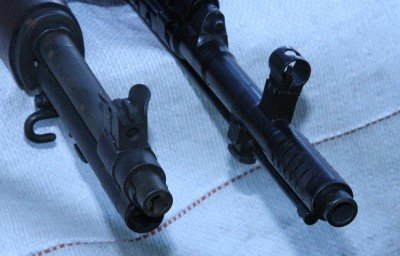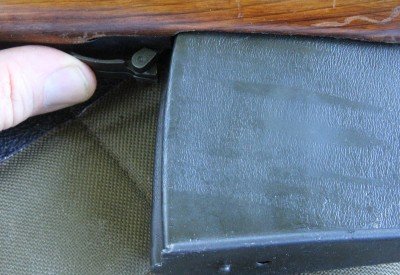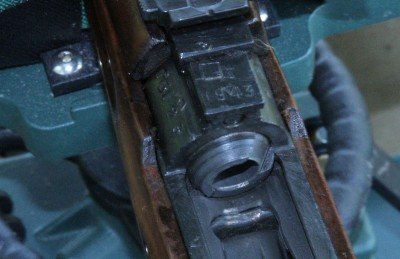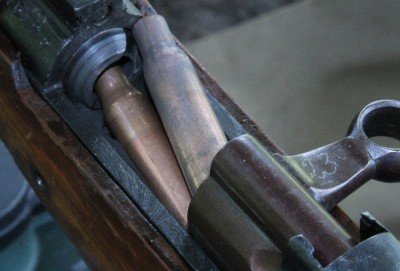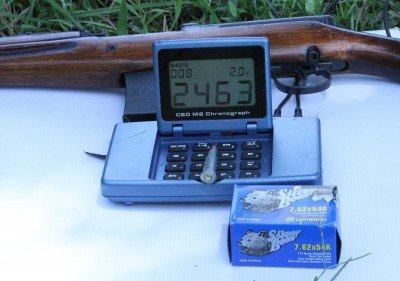
The SVT-40, below, is the Soviet counterpart to the M1 Garand. It was the semi-auto battle rifle of the the Allies on the Eastern Front.
General George S. Patton once called the M1 Garand the “best battle implement ever devised.” But was he correct? The run up to World War II saw a giant leap forward in technology for weapons of war. The jet airplane was invented for WWII. Of course the atomic bomb was invented for WWII. But more importantly, the weapons that saw the most combat, the infantry battle rifles of the war, changed considerably as well, worldwide. In 1936, three years after the famous German false flag the Reichstag fire, and three years before Germany invaded Poland, considered the “official” beginning of WWII, the US adopted a new battle rifle called the M1 Garand. During that time the Soviets also developed a new rifle, introduced in 1938, then re-released in 1940, called the SVT-40. Over 1.6 million of the SVTs were made during the early stages of the war, and many of these rifles came to the US in the 1990s. Many are in collections, but you can still find them if you look, for around $1,200 – $1,500. Was the Garand really a better rifle, or is our American perspective just skewed by nationalistic writers. The SVT-40 never really got out of the gate due to the later popularity of the AK-47, but that doesn’t change the fact that it was an influential rifle on the Eastern front during the war, or the fact that it totally rocks. We got to test an actual 1943 SVT-40 side by side with an M1 Garand, and the results may surprise you.
Semi-Auto vs. Semi-Auto
The SVT-40 is a short stroke gas rifle with the gas tube on top of the barrel, like you see on more modern semi-auto rifles like the FN-FAL. The gas bleeds into the tube from the inside of the barrel on firing, and this moves a piston back, cocking the rifle and chambering the next round. It has a ten round detachable magazine, but because there had been complaints about the magazine getting lost on the SVT-38, the Soviets came up with a clever magazine release that can be locked down by flipping it backward.
Compare that to an M1 Garand. It has a bottom gas tube, and this too pushes an activator rod, but on the Garand the rod cocks to the side and back again. This makes the gun very ammunition sensitive, because too fast a powder or too heavy a bullet can bend the rod. The Garand holds 8 rounds, held in what is called an “en bloc ” clip. This is a piece of spring steel that actually holds the rounds without any outside spring or moving parts, unlike a traditional rifle magazine which can be prone to failure. This is thought to make the M1 Garand a very reliable rifle, and one that is not ruined at the whim of a dented magazine. En bloc clips are cheap and easy to make, and tens of millions were made to support the war effort.
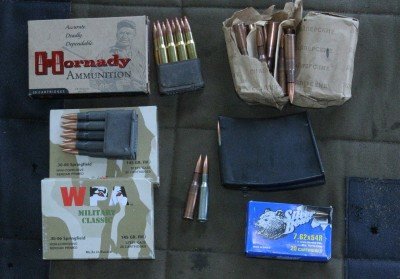
The main difference functionally between the two guns is that the SVT uses a detachable magazine and the Garand uses steel en bloc clips.
As you probably know, the Germans fought most of the infantry war with the bolt action K98 Mauser rifle. They did develop a semi-auto battle rifle, and they did use machineguns and subguns extensively, but for the most part the infantry carried the K98. The Soviets likewise carried a bolt rifle, the Mosin-Nagant, of which we have written extensively. It is a great rifle in its own right, and they are widely available in the US market. What you probably didn’t know is that the official “Table of Organization and Equipment” for the Soviet infantry was supposed to include one third semi-auto SVTs. In the long run that never happened, because of the sheer number of infantry rifles needed for the Eastern Front. It is easier to make a Nagant that it is an SVT, so the bolt rifle won out.
What the infantry soldiers didn’t like about the SVT was overall length of just over 48 inches including the flash hider. Our test rifle is lanky, but it is much better balanced in my opinion than the aforementioned FAL, and I find it handier than even an M14/M1A. Still, it is long, and in house to house fighting you would be at a disadvantage to the 43+ inch M1 Garand. Both rifles have an approximately 24 inch barrel, but the SVT is just spread out more.
The Garand, however, is heavier. Few Garands come in under 10 lbs, and the SVT is only 8 1/2, which is what ours weighed. It is notably lighter, and it doesn’t have that odd fat stock that looks so nifty on Garands, but which makes them awkward to hold and shoot. Dare I say, in fear of a tirade of negative comments, the SVT is more pleasant to shoot. It recoils lighter and has less muzzle rise, and is significantly easier to keep on target in rapid fire standing unrested. I am a huge fan of the M1 Garand and own over a dozen of them, but I would rather have the SVT in a gunfight.
Reliability, Function, and Takedown
At first I was horribly disappointed with my SVT-40. The first rounds stuck in the chamber and I had to use a rubber mallet on the bolt handle to even get the action open. Little did I suspect, the first owner of this gun after importation hadn’t even fired it. I sprayed some Rem-Oil into it and ran a couple mags, and she now works like a charm. I have tried since to get the rifle to fail, by shooting one handed, limp wristing, shooting upside down, but I can’t get it to fail to cycle. The original SVT-38 had some reliability complaints, but I have yet to find anything online suggesting that the SVT-40 has long term reliability issues that would make it have a short range life. I have now put about 300 rounds through my SVT and it hasn’t shown any wear marks or required a re-oiling to function properly. This is amazing considering that the 7.62 x 54R cartridge that it fires has an extended rim, like a revolver cartridge. Those aren’t supposed to work well in magazines, yet they do in the SVT. If you give the M1 Garand a perfect record for reliability, which it definitely does not deserve, the SVT would most likely match it.
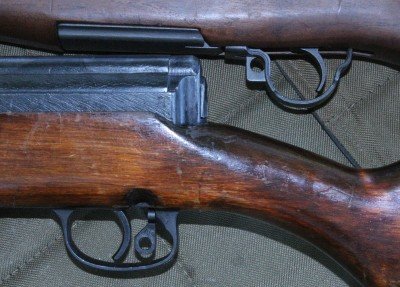
The safety on the SVT is much more usable than the Garand. You flip it sideways instead of back, and it isn’t sticky like a Garand.
The biggest difference in function between the SVT and the Garand is obviously he clip vs. magazine. One thing that I find difficult about the Garand system is that you can’t top off your mag easily. If you shot 6 and you get a lull in the action, it is advisable to drop the mag and top it off, which you can do with the SVT. In fact, with the magazine lock feature of the SVT, you lose nothing. Yes, the magazine sticks out of the bottom of the rifle, and you can damage it. But compared to the cludge of the Garand magazine, it is worth it. The M14 is functionally a Garand with an extended magazine and a shorter cartridge. Both rifles still work fine as a single shot should you lose (or run out of in the case of the Garand) your cartridge holding device, but in a Garand, the guts of the system actually get in the way when you try to do that.
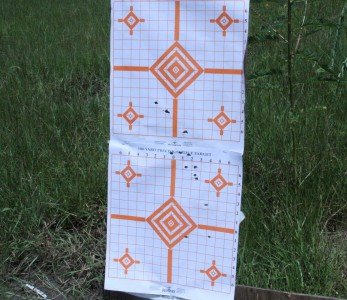
The SVT started out really really really really poor in the accuracy department. This was the group with point of aim at the middle of the top orange diamond.
Taking the Garand down for cleaning is perhaps the simplest of any rifle I have seen. You simply lift the trigger guard and the gun literally falls apart in your hands. The SVT is not so simple. The cleaning rod acts as a switch to allow you to remove the barrel band, and from there the rifle comes apart in stages. It is fairly intuitive, but not as obvious and easy as the Garand. Advantage Garand on this point, but overall, perhaps SVT.
Accuracy
This was another point on which I initially found that the SVT failed miserably. My first volley of 10 rested shots printed into well over a foot of dispersal, so I was like OK, this is why the rifle never got any traction in the long haul. I had read that the SVT was known as a “spray and pray weapon.” But as I shot the rifle more and more, the groups tightened up, and they tightened up considerably.
For these tests, I figured that I would use both a high quality round and a steel cased plinking round, to see how they stacked up against each other in addition to how the rifles themselves stacked up. For the Garand I used Hornady’s 168 grain AMAX bullet M1 Garand rounds for the good stuff and generic Wolf 145 grain steel cased rounds for the cheap stuff. I only shot a couple boxes of the cheap stuff for fear of bending my op rod. For the SVT I used some “7N1 sniper” rounds I got from Lucky Gunner for the good stuff, and the Russian made Silver Bear for the cheap stuff, even though it isn’t the cheapest you can get.
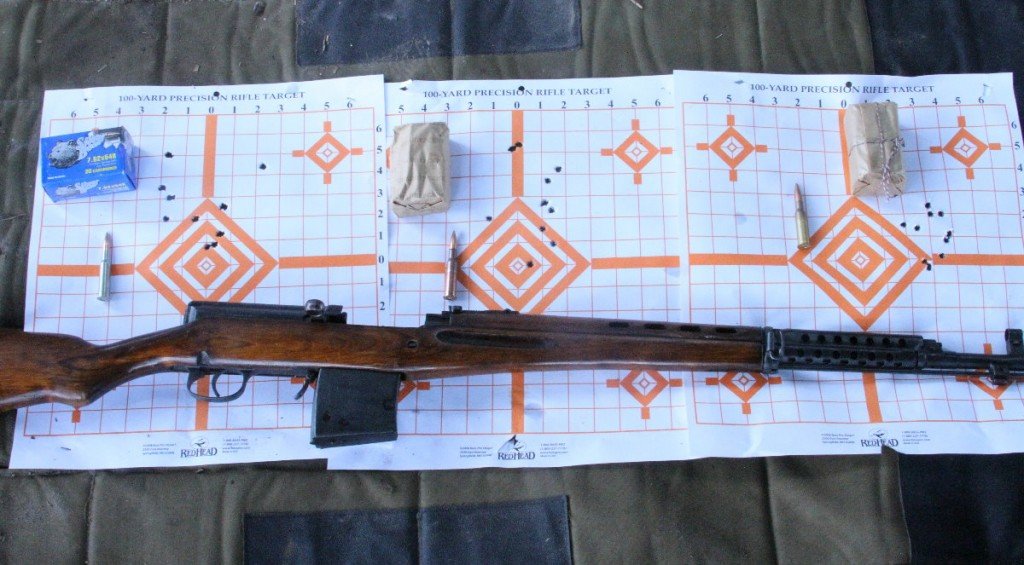
Later the SVT settled in and redeemed itself getting down to 5-6″ of dispersal at 100 yards. Not the best, but with Russian ammo, not terrible either. The shock was when I ran some old sticky surplus Romanian ammo through it, far right.
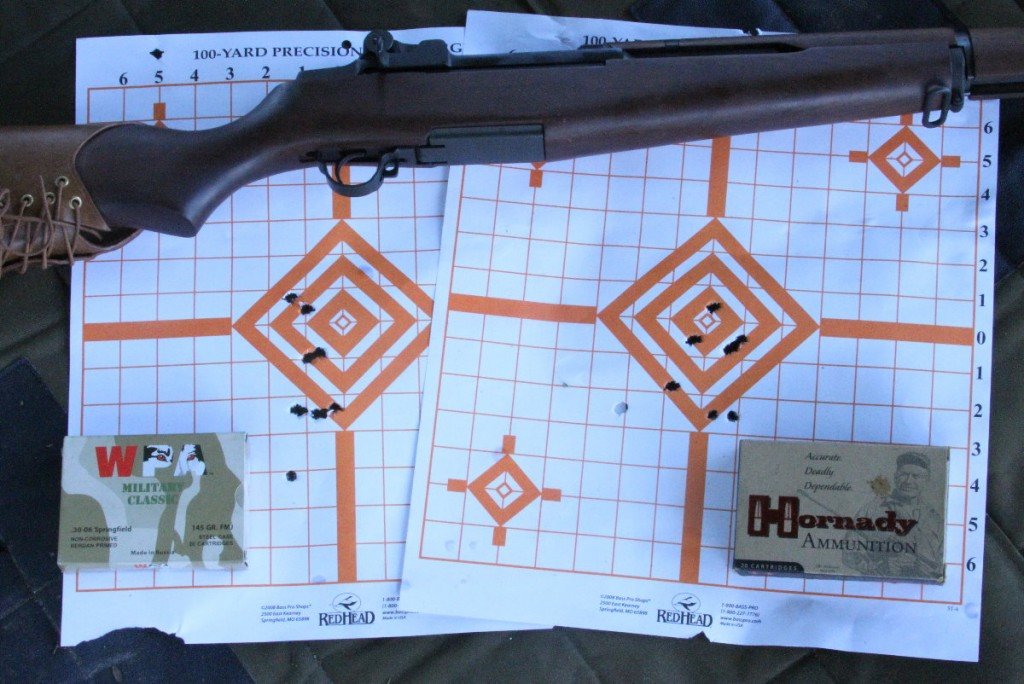
It was no surprise that the Garand shot into under or around 3″ with the Hornady ammo. The cheap steel case ammo spread into just about the same dispersal as the SVT.
The Garand I used was the one from my “Sniper Garands” article that I sent out to have made into an M1C with the side mount scope. It is a commercial Garand that was put out by today’s Springfield Armory in the late 90s using old Garand parts. I chose it because it got left in a basement once and has a rusted crown on the barrel, making it not ideal. As expected though, it still shot until just under 3″ at 100 yards using the Hornady rounds. The steel case rounds strung vertically to 4-5 inches, as you can see in the pictures. This usually means sloppy powder measurement.
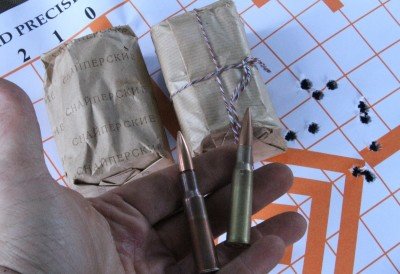
The package on the old Romanian surplus looks a lot like the 7N1, but the rifle liked the sticky stuff much better.
The SVT started out horrible, no matter what the ammo. But eventually both the 7N1 and Silver Bear warmed up to fall within 5-6 inches of dispersal at 100 yards. There was not a chasm of difference between them. The big surprise came when I used some old ammo from another batch by mistake. I bought this ammo many years ago at a gun show in the standard Russian spam can, and it came in brown wrappers tied with red, white and blue string. Over the years I have used this ammo to zero Nagants, because it is useless for any other purpose. It sticks in chambers, so tight that I have had to hammer M44 bolts open. I was shooting the SVT from a rest, when all of a sudden, it didn’t work right. So I pulled back the bolt and the shell ejected. Hmm. Strange. Fire again. Same thing. And I did this for the whole magazine, figuring that I broke the gun and that reporting it would be part of declaring the M1 Garand the overall winner. Nope. It was this old sticky ammo I soon discovered. But when I looked through the scope at the target downrange, lo and behold, the group was about 3 inches. So I shot another. Same thing. And it repeated, every round having to be jacked out of the chamber manually.
This leads me to believe that the SVT is a rifle that really just needs to be broken in, to settle everything out, and that it has a sweet spot for ammo that shoots well in it. The Russian rifle doesn’t like the better Russian ammo, but I didn’t hold this article until I could get some Hornady 7.62x54R. Of course it is going to shoot better! But who has the money to keep a thousand rounds of that stuff on hand? Most likely, if you are buying this gun to plink and collect, you will be shooting the cheap stuff, or buying a few hundred rounds of reloadable brass and rolling your own. If you buy it as your SHTF weapon of choice, and it is a darn good choice, you’ll also most likely be buying the cheap stuff. Just make sure you break your gun in. Advantage Garand in accuracy, but the SVT is not the spray and pray weapon that people claim.
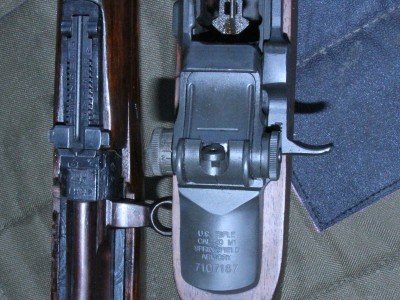
Note that the sights are much better on the Garand than any rifle you might compare it to, old or new. The SVT has the same sights as the Nagant, eh.
One thing I have to point out in comparing these two guns is that the sights on a Garand are far superior to the sight on the SVT. The SVT has a standard notch and post, with a drift adjustable post, and that’s pretty much it. Where it shoots it shoots. Get used to it. The Garand is an absolute pleasure because it has a peep sight that is both windage and elevation adjustable at the turn of a thumbwheel. Peep sights make you shoot better because your eye always naturally centers the aim point on the front sight to the middle. As an “out of the box” battle rifle, there is no comparison to the sight on the M1 Garand. It is the best that has ever been.
So Who Wins?
It is easy to sit back and just accept the M1 Garand propaganda, that is the best blah, blah blah. So why bother with the SVT-40? #1 would be because it is a really cool rifle, and if you can get your hands on one, it helps to go through such a comparison as above so you can see what it is you would be buying. On GunsAmerica they do appear, but only from time to time. Don’t be surprised if you see one at a gunshow for $2,000, because some people know how rare these cool rifles really are, and they don’t let them go easily.
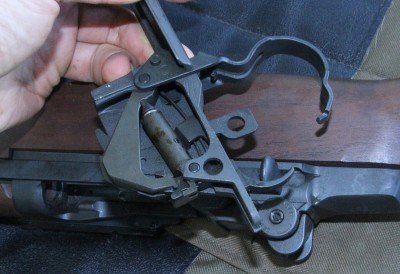
The Garand also take down easier than the SVT, or pretty much any other rifle. You just pop the trigger guard and the rifle falls apart.
In actual comparison, the two rifles, SVT vs. Garand, are not apples and oranges as many would say, but they aren’t that alike either. Parts are readily available for the Garand. That is a big deal if you only have the money for one rifle. Garands can often be found for well under $1,000, but be careful that you don’t buy a rifle with a bent op rod. There is no such thing as a sober person selling an SVT for under $1,000, but you never know when you’ll run into a drunk. As battle rifles go, the M1 Garand endured through two wars, and bred not only the M14, but the M1 Carbine, and even the Ruger Mini-14/30. The SVT-40 didn’t lead to much of anything. It’s design invented nothing really, and it was replaced by the Eastern Bloc countries by the AK-47, which took influence from the German STG-44, not the SVT or any Soviet designed rifle. Nostalgically speaking, the M1 Garand is as romantic as rifles come. The SVT is a vagrant of history at best, but is that simply because America has no use for history of the “other front” in World War II? In a fight for my life would I take an M1 Garand or an SVT-40? Um.
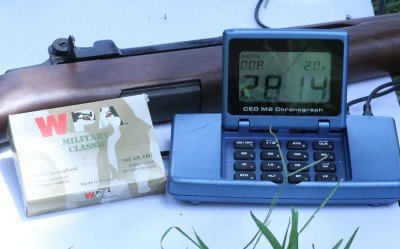
The rifles really have similar ballistics. We chronographed the steel case .30-06 ammo in the 24″ barrel of the Garand and it came up with 2814 average feet per second. That’s 2550 foot pounds of energy.
